Sorte Muld II
Sorte Muld (Danish – “black earth”– Fig. 1), in Ibsker parish, north-east Bornholm, an Iron Age settlement complex (Fig. 2) in use starting from the Pre-Roman Period through to the Viking Age, most active during the →Migration Period , 5th and 6th cc.
The first finds from S.M. were recorded in the 18th century but most of them come from regular metal detector investigations carried out on the surface of the site since the 1980s, mainly by amateur archaeologists – owners of fields and local inhabitants. The result has been the recovery of over 30,000 assorted artefacts, all of them recorded on detailed maps. Included in this assemblage are glass beads (Fig. 3), fragments of Roman and Frankish glass vessels, weapons, tools, some 400 coins (Fig. 4), mostly Roman (including, over 300 denarii and 15 solidi →Solidus) and, most notably, around 2,500 “guldgubber” - miniature stylised human and animal figures impressed in gold foil (Fig. 5.). The physical appearance of the human figures – clothing, hairstyle different attributes and gestures – is depicted in them in painstaking detail. “Guldgubber” are dated to the second half of 6th c. and interpreted as votive offerings made in the sanctuary of a transregional significance. Gold-figure foils have surfaced at more than thirty sites in Scandinavia but so far none are recorded in more southerly regions of Europe. The Bornholm Museum holds a collection of ca. 1800 guldgubber – the largest in the world.
Several gold deposits were discovered at S.M. and in adjacent farmstead-settlements (Fig. 2), often in association with a dwelling. Of two deposits found at Dalshøj one contained at least 17 solidi →Solidus, the other - a silver gilt brooch and gold bars (Fig. 6.). Possibly the most remarkable hoard, placed inside a folded silver Roman vessel, from Fuglesangsager (Fig. 7.), contained Scandinavian bracteats →Scandinavian Bracteat, solidi →Solidus, spacer-beads and ring pendants which find analogies in the deposit from →Suchań in Western Pomerania.
Only a very small area of S.M. was investigated by traditional archaeological excavation; other techniques used include soil sample taking, phosphate level tests, drilling, as well as non-destructive methods such as geomagnetic surveys and air photography. The results were used to create a settlement map of S.M. and its surrounding area. The settlement presumably had at its centre the great hall – seat of the local power elite – as well as a sanctuary and craftsmen’s workshops, especially goldsmiths. Around the site were small single farmstead-settlements; the whole complex covers about 1 km2 and suggests planning as well as careful use of the terrain. Between the settlement and a small port at Vigehavnen – a distance of 2 km – runs a road known as Krøblingevejen (“the winding road”).
The settlement at S.M. played the role of a transregional centre of power and worship, similarly as the complexes at →Gudme in Funen, →Uppåkra in Scania, →Jakuszowice in Lesser Poland, →Janków in Greater Poland and →Gąski in Kuyavia.
AB
Literature: O. Klindt-Jensen, Bornholm i Folkevandringstiden og forudsætningerne i tidlig jernalder, Nationalmuseets Skrifter, Større Beretninger II, København 1957; Ch. Adamsen et alii (eds.), Sorte Muld. Wealth, Power and Religion at an Iron Age Central Settlement at Bornholm, Rønne 2009; M. Watt, Sorte Muld, Bornholm, an example of transformation and regional contacts during the 5th and 7th centuries in the Baltic Sea area, [in:] B. Ludowici (ed.), Transformations in North-Western Europe (AD 300-1000), Proceedings of the 60th Sachsensymposion 19.-23. September 2009, Maastricht, Neue Studien zur Sachsenforschung 3, p. 139-148; H. W. Horsnæs, Crossing Boundaries. An Analysis of Roman Coins in Danish Context, vol. 2: Finds from Bornholm, Publications of the National Museum Studies in Archaeology and History 19, Copenhagen 2013; M. Watt, Guldgubberne og Ibskerbygden, Nordiske Forridsminder, Ser. C (in print).
-
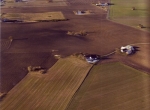 full resolution
full resolution
Fig. 1. Sorte Muld seen from the air (from Ch. Adamsen et alii 2009).
-
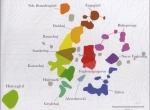 full resolution
full resolution
Fig. 2. Sorte Muld – the settlement complex (from Ch. Adamsen et alii 2009).
-
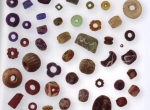 full resolution
full resolution
Fig. 3. Glass beads from Sorte Muld, Bornholm Museum (from Ch. Adamsen et alii 2009).
-
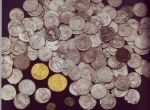 full resolution
full resolution
Fig. 4. Roman coins from Sorte Muld, National Museum in Copenhagen (from Ch. Adamsen et alii 2009).
-
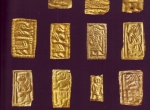 full resolution
full resolution
Fig. 5. Selected guldgubber from Sorte Muld, Bornholm Museum (from Ch. Adamsen et alii 2009).
-
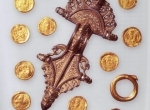 full resolution
full resolution
Fig. 6. Hoards from Dalshøj, National Museum in Copenhagen (from Ch. Adamsen et alii 2009).
-
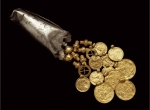 full resolution
full resolution
Fig. 7. The hoard from Fuglesangsager, National Museum in Copenhagen (photo John Lee, from Horsnæs 2013).


